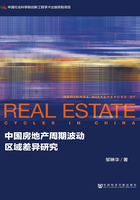
An Analysis about the Regional Differences of Real Estate Cycles in China
Fluctuations orcycles can be observed from the real estate markets of China since the reform and opening up especially from 2002 to 2008. However, we have paid more attention to the national real estate cycles, but paid less attention to the local real estate cycles. Why do regional differences of real estate cycles exist? What is the main reason for the differences? Can the fluctuations orcycles in real estate markets influence the growth of regional economy? What are the dynamic performances of local real estate cycles in China? What is the pattern of regional differences among the China's local real estate markets? These questions have not been solved properly in present research.
In order to answer these questions, this book first constructs a stock-flow model with sticky price and simulates it with the parameters of China's local real estate markets to investigate the influences of the market structure and economic fundamentals on the pattern of local real estate cycles, then builds a dynamic general equilibrium model with financial accelerator to analyze the interaction between real estate cycles and fluctuations of macro(regional)economy. In the empirical analysis of this article first measures and compares the real estate cycles of Beijing, Shanghai, Guangzhou and Shenzhen by using HP filter, spectral density analysis and BP filter, and then estimates the coherency, leading-lag relationships and differences in volatility of real estate cycles among 10 major cities which are located in the eastern, middle and western China by the cross-spectral analysis and other methods.
The simulations of stock-flow model show that if other conditions remain unchanged, the amplitude and persistence of real estate cycles in regional markets will increase when the supply is elastic or demand is rigid; the amplitude,persistence and cycle length will increase when the regional market's price is more sticky; the amplitude and persistence will increase when the regional markets has higher income growth rates or housing depreciation rates; the amplitude, persistence and frequency will increase and the cycles will become more irregular when the regional markets have greater income elasticity; the amplitude and cycle length will increase when the regional markets have longer construction lags.
Under the framework of credit constraint, the simulations of general equilibrium model show that the decline in real estate price will accelerate the decline in total output through the financial accelerator in the contract phase of real estate and business cycles, but the decline in total output will not accelerate the decline in real estate price as feedback. Under the framework of external financial premium, the simulations show that monetary policy can't alleviate the impact of real estate price decline on total output, fiscal policy has some effect on it but will accelerate the investment decline, and has no use in preventing the real estate price decline.
By using HP filter, spectral density analysis and BP filter, this article measures the price cycles, real supply/demand cycles and investment cycles in Beijing, Shanghai, Guangzhou and Shenzhen real estate markets. The results show about 5-6 years and 3 years of price cycles and 15 years of real supply /demand cycles in Beijing market; about 5-6 years of price cycles, 10 years of real supply /demand cycles and 7 years of investment cycles in Shanghai market;about 5-6 years of price cycles, 10 years and 6 years of real supply/ demand cycles and 12 years of investment cycles in Guangzhou market; about 5-6 years of price cycles, 10 years of real supply /demand cycle and 9 years of investment cycles in Shenzhen market. Besides the difference in cycle length, the results also show some differences in the leading-lag relationship among cities by comparing the peaks and troughs of cycles.
The cross-spectral analysis on real estate price cycles of 10 major cities from eastern, middle and western China shows that the coherence of price cycle among eastern cities is larger than coherence among the middle and western cities. The coherence is different among cities which are located in the same region too. Phase spectrum shows diverse leading-lag relationships among the price cycles of cities even though they have large coherence. The dispersion coefficients and beta coefficientsshow that the volatility of price cycles in eastern cities is greater than middle and western cities and price volatility in Shanghai and Shenzhen is larger than volatility in the other eastern cities.
It can be known from the results that there are great differences among real estate cycles in local markets of China. The differences should be seriously considered in making investment portfolios and also cross-regional real estate investments in order to take advantages or hedge risks from market fluctuations. For the government authorities when some policies especially counter-cyclical policies about real estate industry are made, the regional differences of real estate cycles should be seriously considered too.